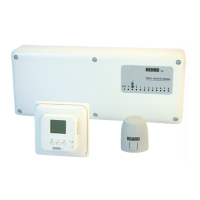7
PRINCIPLES OF CONTROLLING
FLOOR HEATING SYSTEMS (FH)
FIXED FLOW WATER TEMPERATURE (FFT) SYSTEM
A conventional boiler system including radiators and domestic
hot water (DHWS) provides water with a flow temperature in the
region of 80ºC. Water is pumped by a Main (system) pump to the
hot water cylinder and to the radiators, where it loses temperature
and on the return, the water temperature normally stays at around
69ºC. Current standards and regulations for floor heating state
that the surface temperature of a floor must not exceed 29ºC (in
perimeter zones and bathrooms 35ºC). In a traditional underfloor
circuit the flow and return water is mixed via a mixing valve to
achieve a flow temp of between 32ºC-55ºC. This is achieved by
mixing the boiler flow with cooler water from the return of the floor
heating circuits. Once flow set point is achieved the mixing valve
closes to the boiler to stop excess temperature rise.
Commonly there are two main systems in use:
- Fixed Flow Temperature (FFT) system
- Variable Flow Temperature (VFT) system
(also known as weather compensated system).
1.0
1.3
A constant temperature system regulates the amount of warm water
being added from the main system boiler to the water circulating
within the circuits, to maintain the flow temperature in the circuits at
a pre-set level. This constant temperature is mechanically pre-set at a
thermostatic mixing valve (TMV).
It is not possible to influence the mixed water temperature remotely by
a building management system (BMS).
For domestic and smaller commercial applications requiring a
constant temperature system, REHAU offers a small and compact
mixing unit called the compact mixer unit. It is supplied pre-assembled
and is ideal for installations where space is limited.
For larger commercial applications, a traditional system using a 3-Port
thermostatic mixing valve is recommended.

